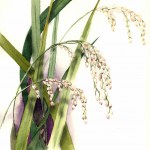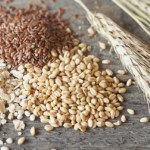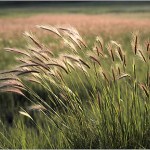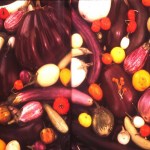plant breeding
Tomorrows Table: What does GMO really mean?
For years, journalists, television producers and newspaper reporters that write about genetically engineered crops, have used the term “GMO” (genetically modified organism) to describe these new crop varieties. The marketing industry has taken to writing “GMO-free” on their products, as a way to increase sales to consumers fearful of the genetic engineering process.The problem is that the term GMO is misused and misunderstood.Take, for example, a recent story on Voice of America about a newly developed rice variety that is…
Finally our paper is in press!
in the coming issue of PNAS, we describe a genome-scale model for predicting the functions of genes and gene networks in rice, an important staple food. Called RiceNet, this systems-level model of rice gene interactions allows us to effectively predict gene function. This information can be used to help boost the production and improve the quality of one of the world's most important food staples.
This graphic is a full-size view of a RiceNet layout, color-coded to indicate the likelihood of network links; red for higher and blue for lower likelihood scores…
This week, the G20 Agriculture Ministers gathered for their first-ever meeting to discuss potential measures to address price volatility and record high food prices. The key to any long-term solution is acknowledging that we need to empower the very people whose lives are most affected by food shortages. Three-quarters of the world's poorest people get their food and income by farming small plots of land. The potential of small farmers for getting us out of this and future food crises cannot be overstated.
Today, we find that millions of lives depend upon the extent to which agricultural…
Today we took the children to Table Mountain, a volcanic mesa in northern California.
It is a special place, preserved from development by the dense, rocky texture of the soil- no good for farming. We strolled through carpets of flowers Lasthenia californica (California goldfields). Blemnosperma nanum (yellow carpet), Lupinus nanus, Triteleia ixiodies (pretty face), Castilleja exserta (purple owls clover), Triphysaria eriantha (Jonnytuck or Butter 'n' eggs), Eschscholzia caespitosa, (foothill poppy), popcorn flower and gaze at the box kites flying overhead. The blue, grey and white match the…
There's a very silly article in the New York Times about controversy over hybrids vs. heirlooms. Yes, this is a real debate. No, it isn't as stark or as stupid as the Times makes it.
There are plenty of horticultural reasons heirlooms can grow glorious fruit. One is size. An heirloom tomato is often a big, robust plant. The central stalk is usually indeterminate: it keeps shooting up after setting fruit. Mr. Ball, of Burpee, recalls a customer telling him about a Brandywine plant that crept into the house through a second-floor window.
An heirloom tomato will also have a lot of leaves, in…
The last common ancestor of plants and animals may have lived 1 billion years ago. Plants and animals have occasionally exchanged genes, but for the most part, have countered selective pressures independently. Microbes (bacteria, eukaryotes, and viruses) were omnipresent threats, influencing the direction of multi-cellular evolution. Receptors that detect molecular signatures of infectious organisms mediate awareness of non-self, and are integral to host defense in plants and animals alike. The discoveries leading to identification of these receptors and their ligands followed a similar…
From the wonderful Agricultural Biodiversity Weblog (a favorite of mine) over at Research Blogging, is a fascinating summary of paper that describes the ways that most modern seed varieties, selected to be used under commercial conditions, don't do as well under organic conditions, because we haven't selected for the qualities that would enable success:
To perform well under organic conditions, varieties need to get a fast start, to outcompete weeds, and they need to be good at getting nitrogen from the soil early on in their growth. Organic farmers tend to use older varieties, in part…
For a short 5 minute tour of Bill Gates tackling the controversy of GE crops, please see the blog ERV. Thanks for the plug ERV
If you have 45 minutes, watch the entire video here. Bill is serious, sincere and a good speaker with important concepts to convey:
The video starts about 11 minutes in.
> WASHINGTON- (AP) The leader of the United States Department of
> Agriculture's National Institute for Food Research, Dr. Roger Beachy,
> admitted that the release of last week's request for proposals (RFP)
> from scientific researchers was "simply a gag to lighten the research
> funding environment" and that the real one will be released this week.
>
> "Researchers are too stressed out; it seems that all they do is write
> grants. The request for proposals to address extremely finite subject
> areas would alienate 95% of them and give them all an opportunity…
A few years ago, next to a small barn converted into a winery, I noticed a flyer asking voters to support Measure M, an initiative in Sonoma county that sought to " prohibit the raising, growing, propagation, cultivation, sale, or distribution of most genetically engineered organisms."
It pictured the destruction in New Orleans wrought by Hurricane Katrina and the bewildered gaze of George W. Bush. The flyer proclaimed "Who do you trust with your family's health and safety? When FEMA failed, more than a million Americans suffered."
That flyer was typical of the misinformation about GE crops,…
Thank you Bill Gates for your work on behalf of farmers and.... for blogging on our book, Tomorrow's Table!
If you don't have time to read the full reviews, here are a few excerpts:
"This is an important book for anyone who wants to learn about the science of seeds and the challenges faced by farmers... I think anyone who reads this book will be convinced of the authors' sincerity and intelligence - even if, like me, you never try any of the cool-sounding recipes...
I gained an understanding of the history of organic farming and learned about some of the very clever ways organic farmers…
Eggplants are found in many colors: green, white, purple, yellow, even striped. They are shaped like cucumbers or apples. They are eaten in Italy as melanzane alla parmigiana, in France as ratatouille, and in the Middle East as baba ghanoush.
My husband Raoul usually grows Imperial Black Beauty, Rosa Bianca, and the hybrids Beatrice and Nadia. We cook them shortly after harvest:
Spicy Eggplant
2 Eggplants, diced into 1/2" cubes
3 tbsp Olive oil
1 Clove of garlic, smashed and chopped
1/2 tsp Chile flakes
1. Sauté smashed and chopped clove of garlic in the olive oil.
2. Add the chile flakes…
Read Emily Waltz' interview with Roger Beachy, the new director for the National Institute of Food and Agriculture (NIFA), the new research funding arm of the US Department of Agriculture (USDA).
What does Beachy's appoinment mean for researchers, farmers and consumers?
Larger, longer grants with more money for education or extension, so the knowledge can reach from the lab to the food to the fork; a stonger focus on sustinable approaches; and a regulatory stucture that is science based
We need to build enhanced capacity in the US to address urgent agricultural challenges such as sustainable…
Last year, I attended a Food Symposium at the Mountainfilm festival in Telluride.
Many of the speakers offered a simple solution to feeding the world in the face of a population that is expected to grow to 9.2 billion by the year 2050: Eat local.
But how much impact will the "locavore" movement really have on sustainable food production?
Not much, says James McWIlliams in his latest book "Just Food". "Eating local is not, in and of itself, a viable answer to sustainable food production on a global level."
"We should not delude ourselves into thinking that the relatively easy decision to…
The plot thickens.
Reuter's reports that DuPont submitted an 18-page report to the U.S. departments of justice and agriculture last Friday, alleging that Monsanto is unfairly using monopoly powers to drive up prices and defeat the competition. DuPont is asking U.S. regulators to force Monsanto to "rein in" its activities.
My fabulous former student Karl Haro von Mogel has just posted another one of his plant breeding videos, this time on tomato and potato breeding. Check it out!





